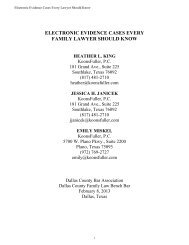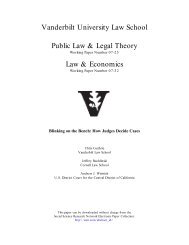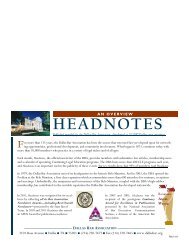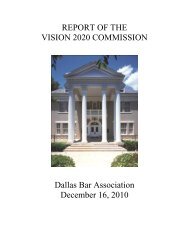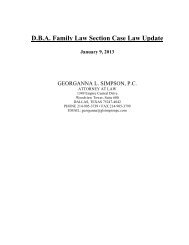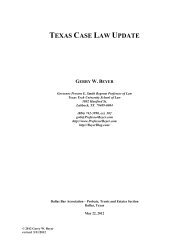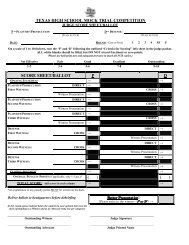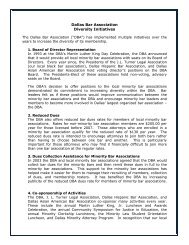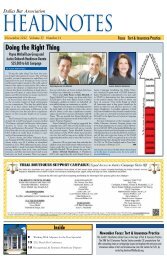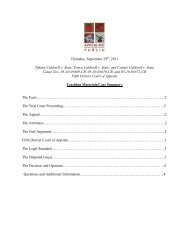IV.SUBORDINATION, NON-DISTURBANCE AND ATTORNMENT AGREEMENTS.A. Definition.Through the use of the SNDA, lenders <strong>and</strong> tenants are able to avoid the analysis <strong>and</strong>uncertainties incident to determinations of relative priorities of their respective interests in realestate <strong>and</strong> provide additional <strong>agreements</strong> that are generally in the best interests of both the lender<strong>and</strong> the tenant.As the title of the instrument suggests, the SNDA contains several elements:(a) <strong>subordination</strong> of the leasehold interest to the mortgage; (b) the lender’s agreement of <strong>nondisturbance</strong>in favor of the tenant <strong>and</strong> (c) the tenant’s agreement of <strong>attornment</strong> in favor of thelender or other purchaser at a foreclosure sale. Although the foregoing elements are the majorcomponents of an SNDA, note that an SNDA may contain other elements as well.B. Elements.1. Subordination. The holding in Ontiveros, 751 F. Supp. at 128, gives a clearexample of the reason lenders often require assurance that all leases have been subordinated totheir mortgage. In anticipation of the lender's requirements, a st<strong>and</strong>ard provision of many leasesis a specific <strong>subordination</strong> provision. In this provision, the tenant expressly subordinates itsrights under the lease to the rights of any existing or future lender. Similarly, a <strong>subordination</strong>provision within an SNDA makes the tenant’s rights under the lease subordinate <strong>and</strong> inferior tothe rights of the lender's mortgage.However, a simple <strong>subordination</strong> of the leasehold estate, without more, subjectsboth the mortgagee <strong>and</strong> the tenant to the risk of termination of the lease upon a foreclosure, aprospect both parties will generally want to avoid. The tenant will generally want to remain inpossession of the leased space <strong>and</strong> the mortgagee will want assurance that it or its purchaser at aforeclosure sale will have the benefit of continued receipt of rental income after the foreclosuresale, provided that the tenant is not in default under the lease.2. Non-Disturbance. The lender’s covenant of non-disturbance in the SNDA is itsagreement that, notwithst<strong>and</strong>ing a future foreclosure, the l<strong>and</strong>lord <strong>and</strong> tenant relationship willcontinue following the foreclosure, <strong>and</strong> the tenant's possession of the leased premises will not bedisturbed, provided the tenant has complied <strong>and</strong> continues to comply with the terms of the lease.The lender’s agreement of non-disturbance, however, probably does not give the lender what it isseeking: the tenant’s reciprocal agreement to recognize the purchaser at the foreclosure sale asthe new l<strong>and</strong>lord <strong>and</strong> to render to that purchaser the benefits to which the former l<strong>and</strong>lord wasentitled.3. Attornment. The concept of <strong>attornment</strong> dates back to medieval days in which thelord of a feudal estate would grant to another the services of his tenant. As a condition of thegrant’s effect, the tenant would attorn to the grantee with words such as “Sir, I attorn to you byforce of the said grant”, or “I become your tenant.” Fisher <strong>and</strong> Goldman, The Ritual DanceD-SNDAs 11-10-07 - 8 -
Between Lessee <strong>and</strong> Lender--Subordination, Nondisturbance <strong>and</strong> Attornment, 30 Real Property,Probate <strong>and</strong> Trust Law Journal 355 (1996).In the context of today’s real estate practice, <strong>and</strong> in particular this discussion, an<strong>attornment</strong> agreement is the tenant’s agreement to “attorn to” or recognize a purchaser atforeclosure as the new l<strong>and</strong>lord under the lease. The tenant's covenant of <strong>attornment</strong> is thetenant’s agreement to render to the l<strong>and</strong>lord all of the rights <strong>and</strong> benefits afforded the originall<strong>and</strong>lord under the lease. Thus, in attorning to the purchaser, the tenant agrees that the purchaseris the holder of the l<strong>and</strong>lord’s interest in the leasehold estate <strong>and</strong> is entitled to receive the rentalpayments <strong>and</strong> other benefits to which the l<strong>and</strong>lord is entitled under the lease. The SNDA willcontain the tenant’s agreement to the effect that if a foreclosure or conveyance in lieu offoreclosure occurs, the tenant will recognize the purchaser at the foreclosure sale as the l<strong>and</strong>lordunder the lease.V. DRAFTING AND NEGOTIATING CONSIDERATIONS.For the reasons described above, whether you represent the l<strong>and</strong>lord or the tenant, it isimportant to consider the need for an SNDA during lease negotiations.From the l<strong>and</strong>lord’s perspective, whether or not the property is currently financed, it iscritically important to maintain the property’s attractiveness to lenders. If the l<strong>and</strong>lord placesleases that would be superior to future mortgages, the l<strong>and</strong>lord may severely compromise thel<strong>and</strong>lord’s ability to obtain future financing or even to sell the property. The property will be lessattractive to lenders because superior leases present all of the problems described in theOntiveros case: potential lender liability for the l<strong>and</strong>lord’s pre-foreclosure defaults, the risk thelender will be bound by all lease amendments, including those made after the date of thefinancing, <strong>and</strong> the possibility the purchaser at foreclosure will be deemed to have assumed thelease by accepting rental payments. Therefore, the l<strong>and</strong>lord should be sure the l<strong>and</strong>lord’s leaseform makes the lease automatically subordinate to all existing <strong>and</strong> future financing of any kind<strong>and</strong> requires the tenant, upon request, promptly to execute <strong>and</strong> to deliver a <strong>subordination</strong>agreement expressly subordinating the lease to any liens. The l<strong>and</strong>lord’s lease form should alsospecify the number of days within which the tenant must sign <strong>and</strong> return the SNDA.The tenant should be willing to agree to subordinate the lease to existing or future liens,but the tenant should condition its <strong>subordination</strong> on the lender’s execution <strong>and</strong> delivery of a <strong>nondisturbance</strong>agreement in a form reasonably acceptable to the tenant. The tenant shoulddetermine if the project is currently subject to financing. If the property is currently financed, thetenant should insist upon obtaining an SNDA within a certain number of days after the date ofthe lease, or as a condition to the tenant’s obligation to pay rent. The tenant should be carefulnot to assume mistakenly that a simple <strong>subordination</strong> agreement will be satisfactory. Asdiscussed above, a <strong>subordination</strong> agreement without the lender’s reciprocal non-disturbanceagreement does not solve any of the tenant’s problems because it will not assure that the leaseremains in force or that the tenancy will not be disturbed.Normally, the SNDA should be signed by the l<strong>and</strong>lord as well as by the tenant <strong>and</strong> thelender in order to ensure the l<strong>and</strong>lord is bound by whatever <strong>agreements</strong> concerning the lease areD-SNDAs 11-10-07 - 9 -



